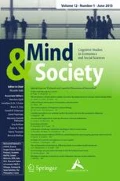Abstract
We explored the relationship between qualities of victims in hypothetical scenarios and the appearance of framing effects. In past studies, participants’ feelings about the victims have been demonstrated to affect whether framing effects appear, but this relationship has not been directly examined. In the present study, we examined the relationship between caring about the people at risk, the perceived interdependence of the people at risk, and frame. Scenarios were presented that differed in the degree to which participants could be expected to care about the group and the extent to which the group could be construed as interdependent. A framing effect was found only for the scenario describing the victims as the participants’ friends who did not know each other (high caring/low interdependence), and this went in the opposite direction from typical framing effects. Finally, perceived interdependence and caring affected choice both within and across scenarios, with more risky choices made by participants with high interdependence ratings and high caring ratings.

Similar content being viewed by others
Notes
The data discussed here were collected for an honors’ thesis by Josh Sager.
We thank a reviewer for raising this point.
One participant neglected to respond to the scaled caring item so only 359 responses are used in the caring analyses.
Percentage of risky choices across both frames did not differ significantly between any of the four scenarios; comparing the two scenarios that received higher interdependence ratings (own family and other family) with the other two scenarios did not yield a significant effect on choice, nor comparing the two scenarios that received higher caring ratings (own family and friends) with the other two scenarios. However, comparing the two scenarios given higher interdependence ratings with the other two scenarios did yield a significant effect on choice in the negative frame, with these scenarios prompting more risky choices (χ 2 = 3.89, P < .05).
It is always a possibility that the scales for interdependence and caring may have been measuring another trait in participants, such as the way they use scales. We thank a reviewer for bringing this issue to our attention.
There is the possibility that the relationship between caring and interdependence ratings and risky choice arose from an order effect. Participants may have provided higher ratings for the interdependence and caring scales in order to justify having made a risky choice. Even if this is true, however, it still demonstrates that participants feel that a risky choice is more appropriate for more interdependent groups and for those groups about which they care more.
References
Bloomfield A (in press) Group size and the framing effect: threats to human beings and animals. Mem Cognition
Fagley NS, Miller P (1990) The effect of framing on choice: interactions with risk taking propensity, cognitive style, and sex. Pers Soc Psychol B 16:496–510
Fagley NS, Miller P (1997) Framing effects and arenas of choice: your money or your life? Organ Behav Hum Dec 71:355–373
Kahneman D, Tversky A (1979) Prospect theory: an analysis of decision under risk. Econometrica 47(2):263–292
Kühberger A (1995) The framing of decisions: a new look at old problems. Organ Behav Hum Dec 62:230–240
Kühberger A (1998) The influence of framing on risky decisions: a meta-analysis. Organ Behav Hum Dec 75:23–55
Levin I, Chapman D (1990) Risk-taking, frame of reference, and characterization of victim groups in AIDS treatment decisions. J Exp Soc Psychol 26:421–434
Mandel D (2001) Gain-loss framing and choice: separating outcome formulations from descriptor formulations. Organ Behav Hum Dec 85:56–76
Markowitz H (1952) The utility of wealth. J Polit Econ 60(2):151–158
Rode C, Wang XT (2000) Risk-sensitive decision making examined within an evolutionary framework. Am Behav Sci 43:926–939
Tversky A, Kahneman D (1981) The framing of decisions and the psychology of choice. Science 211(4481):453–458
Wang XT (1996a) Domain-specific rationality in human choices: violations of utility axioms and social contexts. Cognition 60:31–63
Wang XT (1996b) Framing effects: dynamics and task domains. Organ Behav Hum Dec 68:145–157
Wang XT (1996c) Evolutionary hypotheses of risk-sensitive choice: age differences and perspective change. Ethol Sociobiol 17:1–15
Wang XT, Johnston VS (1995) Perceived social context and risk preference: a re-examination of framing effects in a life-death decision problem. J Behav Decis Making 8(4):279–293
Wang XT, Simons F, Bredart S (2001) Social cues and verbal framing in risky choice. J Behav Decis Making 14:1–15
Acknowledgments
This research was partially supported by NSF grant 9983260. The authors would like to thank Russ Burnett, Serge Blok, and Carmen Tanner for their comments on this work.
Author information
Authors and Affiliations
Corresponding author
Appendix
Appendix
1.1 Own family scenario
Imagine that six of your immediate family members are infected by a fatal disease. Without treatment, they will all die. Two medical treatments to treat the disease have been proposed. Assume that the exact scientific estimates of the consequences of each plan are as follows:
1.2 Other family scenario
Imagine that six of someone else’s family members are infected by a fatal disease...
1.3 Friends scenario
Imagine that six of your friends who do not know one another are infected by a fatal disease...
1.4 Strangers scenario
Imagine that six people are infected by a fatal disease...
Rights and permissions
About this article
Cite this article
Bloomfield, A.N., Sager, J.A., Bartels, D.M. et al. Caring about framing effects. Mind & Society 5, 123–138 (2006). https://doi.org/10.1007/s11299-006-0013-3
Received:
Accepted:
Published:
Issue Date:
DOI: https://doi.org/10.1007/s11299-006-0013-3




